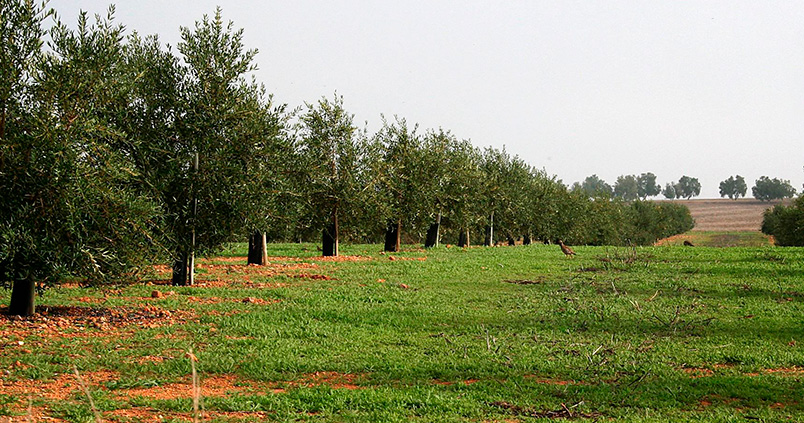Sequestering carbon is equivalent to 350 euros per hectare of olive grove.

Sequestering carbon is equivalent to 350 euros per hectare of olive grove.
With the entry into force of the new CAP 2023-27 and the Green Pact, the strategy used by the EU to combat climate change, it seems more than definite that the new environmental tools will mark the future of the countryside.
Moreover, it should be borne in mind that one of the main environmental challenges facing Spain and Europe is to reach climate neutrality by 2050, which requires a 55% reduction in total emissions at national level over the next eight years (2030) compared to pre-industrial levels.
On the other hand, how the future CAP eco-schemes and the level of environmental measures will materialise remains to be decided.
In this context, the Regulatory Council of the Estepa Designation of Origin, as part of the "José Humanes" Chair of Olive Growing, which is celebrating its 9th edition, has addressed the important role played by olive groves in the fight against climate change and the profitability that this could mean for olive growers. In addition, the PDO has become a pioneering area in studies that seek to endorse the olive grove as a reference crop for the sequestration of C02.
"The olive grove is very efficient when it comes to transferring CO2 from the atmosphere to the crop in the form of organic carbon," says Roberto García, a researcher at the University of Jaén and participant in the Sustainolive project.
The expert, through the study of 24 farms of different types (dry, irrigated, intensive, traditional...) has calculated an average annual carbon sequestration of 3.5 tonnes per hectare. "The olive grove is one of the crops that accumulates the most organic carbon, transferring it from the atmosphere to its permanent structure, which includes the trunk, primary branches and roots," he explains.
In addition, it allows part of the CO2 to accumulate in the soil through the biomass, "an advantage that other oil-producing crops, such as sunflower, do not have".
With regard to practices to increase carbon sequestration, thus promoting a more sustainable crop, Roberto García highlights plant cover as "essential". "In addition to transferring organic carbon to the soil and enriching it, it increases biodiversity and reduces erosion," he says. Mulching, which is part of what is known as "conservation agriculture", is also in line with the eco-regimes of the new CAP, which link a percentage of aid to environmentally friendly practices.
Furthermore, the shredding of pruning residues and their subsequent application also increases soil organic carbon. The use of manure-based fertilisers and composted pomace are other sources of carbon that can be used in olive groves. "The carbon that is in the soil can last for hundreds of years, and the carbon that the olive grove accumulates for as long as the tree lasts, which can also be decades, we have to start taking into account that a large part of the plant remains are carbon and are beneficial," García explains.
Moreover, recent research by the University of Cordoba has shown that olive groves managed with international tillage sequester less carbon than those in which sustainable practices have been implemented. Specifically, in traditional olive groves, a loss of carbon sequestration of between 0.8% (in the first 40 cm of soil) and 2.1% (if the entire soil profile is considered) has been detected.
How to monetise it
But how can we take advantage of these new sustainable practices, which are becoming increasingly widespread, to increase the profitability of olive farms? Roberto García says that, as part of the strategy known as "carbon farming", the European Union is preparing the regulation that will unify the conditions for trading this carbon in a free market, and which will include the conditions to be met by certifying companies.
"The future is that there will be intermediaries who certify that the olive grove sequesters a certain amount of carbon and that same intermediary will sell it to another company that pays for that carbon," he says. It is worth remembering that carbon credits, which are used to facilitate the calculation of the amount of gases that are released into the air, compensating the emission of the companies that emit them and those that acquire them, were already included in the Kyoto Protocol.
The simplified mechanism is that, by selling their positive carbon balance, farmers receive a financial reward for every tonne of carbon dioxide the crop captures from the atmosphere.
According to Roberto García's calculations, if each hectare of olive groves sequesters 3.5 tonnes of CO2 on average, and each tonne is worth 85 euros, "a hectare of olive groves can generate 250 euros annually simply by implementing management practices aimed at boosting carbon capacity". For this reason, the expert encourages farmers to join this sustainable trend, which can also produce economic benefits.
On the other hand, there are already companies offering farmers financial returns in exchange for promoting carbon sequestration, although the uncertainty in which the sector is immersed, on the eve of the new CAP, has paralysed many financial operations until it is clear how the eco-regimes, the great novelty, will be applied and what percentages of farmers will carry them out.
Original article: ABC.es





